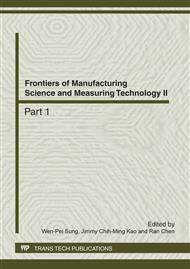p.1385
p.1389
p.1393
p.1397
p.1401
p.1408
p.1412
p.1416
p.1420
Study on the Calibration Method for Orthogonal 3D Scanning Probe System Based on the Linear Calibration Matrix
Abstract:
Gear Measuring Center(GMC) is a kind of instrument for measuring the accuracy of the tooth surface. For the gears whose modulus is not small, the contact measuring method is commonly used. 3D scanning probe is the key component. Because it can reflect the trend of 3D error of the tooth surface, and has the advantages of high-speed and high-precision, it is generally used in the measurement of complex and large gear. However, due to the anisotropy of the mechanical structure of the probe itself and the influence of the external environment factors, it will result in mutual influence among the three deformation directions of the probe, that is coupling phenomenon, therefore it must be calibrated before measurement. In the paper, on the basis of the structure of 3D scanning probe and measurement principle, the varying coefficients linear calibration matrix was innovatively proposed. Through measuring the points planned on the standard ball, based on the spherical equation, the overdetermined nonlinear equations were established. The equations were iteratively solved with the least squares method and genetic algorithm. The calibration matrix was finally experimental verified. The experimental results show that the linear calibration matrix has higher calibration precision than traditional constant coefficient calibration matrix, the calibration method has the advantages of high-efficiency and high-precision, it has a certain reference meaning for the research of the calibration of the probe.
Info:
Periodical:
Pages:
1401-1407
Citation:
Online since:
April 2012
Authors:
Price:
Сopyright:
© 2012 Trans Tech Publications Ltd. All Rights Reserved
Share:
Citation:


